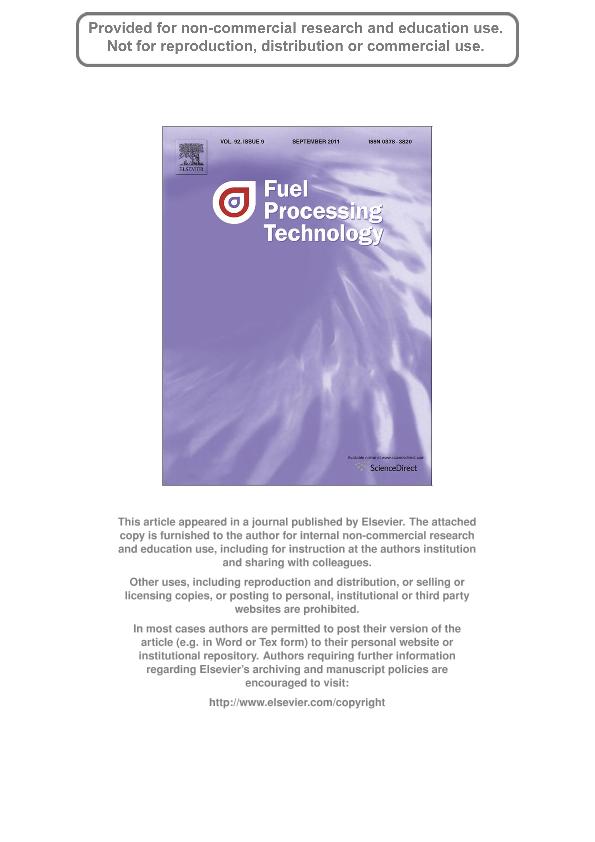Mostrar el registro sencillo del ítem
dc.contributor.author
Busto, Mariana

dc.contributor.author
Vera, Carlos Roman

dc.contributor.author
Grau, Javier Mario

dc.date.available
2020-03-25T21:42:48Z
dc.date.issued
2011-09
dc.identifier.citation
Busto, Mariana; Vera, Carlos Roman; Grau, Javier Mario; Optimal process conditions for the isomerization-cracking of long-chain n-paraffins to high octane isomerizate gasoline over Pt/SO4 2--ZrO2 catalysts; Elsevier Science; Fuel Processing Technology; 92; 9; 9-2011; 1675-1684
dc.identifier.issn
0378-3820
dc.identifier.uri
http://hdl.handle.net/11336/100839
dc.description.abstract
An assessment of the process conditions for the isomerization-cracking of long-chain n-paraffins over commercial Pt/SO42--ZrO 2 catalysts was made. Pretreatment and reaction conditions were optimized with a focus on the maximization of the yield of short, high octane branched paraffins for the gasoline pool. While selectivity was an important issue attention was also paid to the reduction of the yield to gases (C 1-C4). Therefore cracking had to be modulated to produce the correct molecular size adjustment without scission to too much smaller fragments. Skeletal isomerization was to be maximized. The activity in both acid-catalyzed reactions had to be tuned while keeping a stable activity level. The only pretreatment condition assessed was the calcination temperature (screened in the 600-800 °C range). Calcination at 600 °C produced the highest activity level while 700 °C was convenient from the point of view of selectivity. The optimum temperature coincided with the production of the highest concentration of Brönsted acid sites. Regarding the reaction conditions, increasing temperature values augmented the conversion but also increased the cracking. Therefore optimum values were found at a moderate temperature, 225 °C, given the high reactivity of the feed. Space velocity values were analyzed with attention to the liquid C5+ yield, the selectivity to branched isomers and the stability of the catalysts. Best yields to branched naphtha products were obtained at WHSV = 18 h- 1. The H2/hydrocarbon molar ratio was a function of the catalyst coking rate. A value of 10 was enough to attain a stable conversion value. The values of liquid yield as a function of pressure displayed a volcano pattern that was rationalized in terms of a non-classical bifunctional mechanism of reaction. High pressure values increased the concentration of Brönsted acid sites and hence the activity while high pressures enhanced hydrocracking and decreased the liquid yield. The optimal pressure value was 20 atm.
dc.format
application/pdf
dc.language.iso
eng
dc.publisher
Elsevier Science

dc.rights
info:eu-repo/semantics/openAccess
dc.rights.uri
https://creativecommons.org/licenses/by-nc-sa/2.5/ar/
dc.subject
CRACKING
dc.subject
GASOLINE
dc.subject
ISOMERIZATION
dc.subject
N-HEXADECANE
dc.subject
REACTION CONDITIONS
dc.subject
SULFATE-ZIRCONIA
dc.subject.classification
Otras Ingeniería Química

dc.subject.classification
Ingeniería Química

dc.subject.classification
INGENIERÍAS Y TECNOLOGÍAS

dc.title
Optimal process conditions for the isomerization-cracking of long-chain n-paraffins to high octane isomerizate gasoline over Pt/SO4 2--ZrO2 catalysts
dc.type
info:eu-repo/semantics/article
dc.type
info:ar-repo/semantics/artículo
dc.type
info:eu-repo/semantics/publishedVersion
dc.date.updated
2020-03-25T13:45:51Z
dc.journal.volume
92
dc.journal.number
9
dc.journal.pagination
1675-1684
dc.journal.pais
Países Bajos

dc.journal.ciudad
Amsterdam
dc.description.fil
Fil: Busto, Mariana. Consejo Nacional de Investigaciones Científicas y Técnicas. Centro Científico Tecnológico Conicet - Santa Fe. Instituto de Investigaciones en Catálisis y Petroquímica "Ing. José Miguel Parera". Universidad Nacional del Litoral. Instituto de Investigaciones en Catálisis y Petroquímica "Ing. José Miguel Parera"; Argentina
dc.description.fil
Fil: Vera, Carlos Roman. Consejo Nacional de Investigaciones Científicas y Técnicas. Centro Científico Tecnológico Conicet - Santa Fe. Instituto de Investigaciones en Catálisis y Petroquímica "Ing. José Miguel Parera". Universidad Nacional del Litoral. Instituto de Investigaciones en Catálisis y Petroquímica "Ing. José Miguel Parera"; Argentina
dc.description.fil
Fil: Grau, Javier Mario. Consejo Nacional de Investigaciones Científicas y Técnicas. Centro Científico Tecnológico Conicet - Santa Fe. Instituto de Investigaciones en Catálisis y Petroquímica "Ing. José Miguel Parera". Universidad Nacional del Litoral. Instituto de Investigaciones en Catálisis y Petroquímica "Ing. José Miguel Parera"; Argentina
dc.journal.title
Fuel Processing Technology

dc.relation.alternativeid
info:eu-repo/semantics/altIdentifier/url/http://www.sciencedirect.com/science/article/pii/S0378382011001317
dc.relation.alternativeid
info:eu-repo/semantics/altIdentifier/doi/http://dx.doi.org/10.1016/j.fuproc.2011.04.010
Archivos asociados
